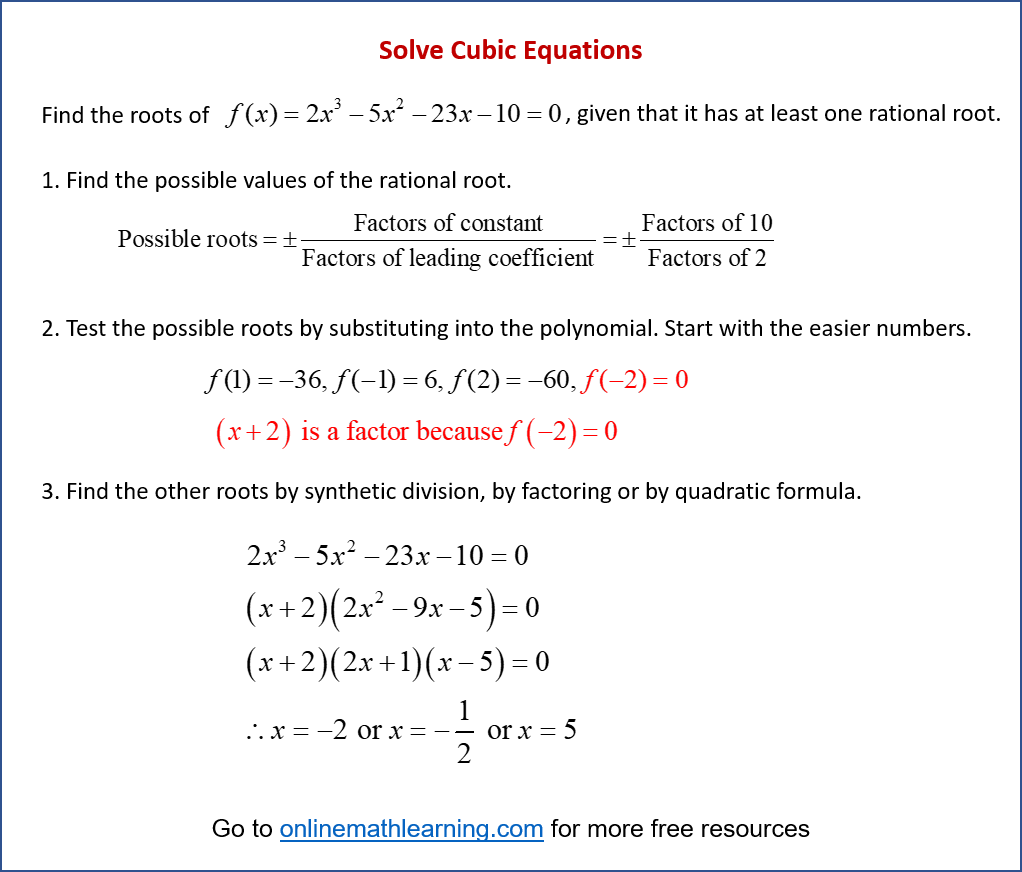Solving Cubic Equations
Related Pages
Cubic Functions
Factor Theorem
Remainder Theorem
More Algebra Lessons
More Algebra Games
In these lessons, we will learn how to solve cubic equations using the Remainder Theorem and the Factor Theorem.
Printable & Online Algebra Worksheets
What is the Remainder Theorem?
If a polynomial, f(x), is divided by x - k, the remainder is equal to f(k).
What is the Factor Theorem?
x - k is a factor of the polynomial f(x) if and only if f(k) = 0
How to solve cubic equations using the Factor Theorem?
In these lessons, we will consider how to solve cubic equations of the form
px3 + qx2 + rx + s = 0 where p, q, r and s are constants by using the
Factor Theorem and Synthetic Division.
The following diagram shows an example of solving cubic equations. Scroll down the page for more examples and solutions on how to solve cubic equations.

Example:
Find the roots of f(x) = 2x3 + 3x2 – 11x – 6 = 0, given that it has at
least one integer root.
Solution:
Since the constant in the given equation is a 6, we know that the integer root must be a factor of 6.
The possible values are ![]()
Step 1: Use the factor theorem to test the possible values by trial and error.
f(1) = 2 + 3 – 11 – 6 ≠ 0
f(–1) = –2 + 3 + 11 – 6 ≠ 0
f(2) = 16 + 12 – 22 – 6 = 0
We find that the integer root is 2.
Step 2: Find the other roots either by inspection or by synthetic division.
2x3 + 3x2 – 11x – 6
= (x – 2)(ax2 + bx + c)
= (x – 2)(2x2 + bx + 3)
= (x – 2)(2x2 + 7x + 3)
= (x – 2)(2x + 1)(x +3)
So, the roots are ![]()
Example:
Solve the cubic equation x3 – 7x2 + 4x + 12 = 0
Solution:
Let f(x) = x3 – 7x2 + 4x + 12
The possible values are ![]()
We find that f(–1) = –1 – 7 – 4 + 12 = 0
So, (x + 1) is a factor of f(x)
x3 – 7x2 + 4x + 12
= (x + 1)(x2 – 8x + 12)
= (x + 1)(x – 2)(x – 6)
So, the roots are –1, 2, 6
What are The Remainder Theorem and the Factor Theorem?
How to use the Theorems to find the linear factorization of a polynomial?
Example: Factor F(x) = 2x3 − 3x2 − 5x + 6
How to use the Factor Theorem to factor polynomials?
Examples:
- Factor P(x) = 3x3 − x2 − 10x + 8
- Factor P(x) = 2x3 − 9x2 + x + 12
How to use the Factor Theorem to solve a cubic equation?
If f(x) is a polynomial and f(p) = 0 then x - p is a factor of f(x)
Example: Solve the equation 2x3 −5x2 − 10 = 23x
How to solve Cubic Equations using the Factor theorem and Long Division?
Example: Find the roots of the cubic equation 2x3 − 6x2 + 7x − 1 = 0
How to solve Cubic Equations using the Factor theorem and Synthetic Division?
Example: Show that x + 3 is a factor of x3 − 19x − 30 = 0. Then find the remaining factors of f(x)
How to solve cubic equation problems?
Example: 3x3 −4x2 − 17x = x3 + 3x2 − 10
Step 1: Set one side of equation equal to 0.
Step 2: Collect like terms.
Step 3: Factorize using the Factor Theorem and Long Division
Try the free Mathway calculator and
problem solver below to practice various math topics. Try the given examples, or type in your own
problem and check your answer with the step-by-step explanations.

We welcome your feedback, comments and questions about this site or page. Please submit your feedback or enquiries via our Feedback page.